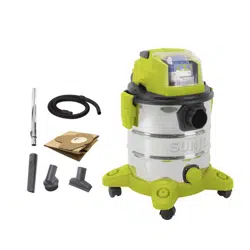Loading ...
Loading ...
Loading ...

16
1. To reduce the risk of injury and damage, never immerse
your battery pack or charger in liquid or allow any liquid to
ow inside these components.
2. Clean out dust and debris from charger vents and
electrical contacts by blowing with compressed air.
3. Use only a soft, clean and dry brush to clean the battery
pack and charger, keeping away from all electrical
contacts. Certain cleaning agents and solvents are harmful
to plastics and other insulated parts. Some of these
include gasoline, turpentine, lacquer thinner, paint thinner,
chlorinated cleaning solvents, ammonia and household
detergents containing ammonia. Never use ammable
or combustible solvents around battery packs, battery
chargers or tools.
Storage
1. Examine the cordless wet/dry vacuum thoroughly for
worn, loose or damaged parts. Should you need to repair
or replace a part, contact an authorized Snow Joe
®
+
Sun Joe
®
dealer or call the Snow Joe
®
+ Sun Joe
®
customer service center at 1-866-SNOWJOE
(1-866-766-9563) for assistance.
2. Examine the lters thoroughly for signs of excess wear
or damage. If they are worn or damaged, replace them
immediately.
3. Store the wet/dry vacuum indoors in a clean, dry and
locked location out of the reach of children and animals.
4. When not in use, the equipped tubes, handles and nozzles
can be temporarily stored on the casters of the unit as
shown (Fig. 24).
Battery + Charger O-Season Storage
1. Do not expose your battery pack or charger to water,
rain or allow them to get wet. This could permanently
damage the charger and the battery pack. Do not use oil
or solvents to clean or lubricate your battery pack as the
plastic casing can become brittle and crack, causing a
serious risk of injury.
2. Store the battery pack and charger at room temperature
away from moisture. Do not store in damp locations where
corrosion of terminals may occur. As with other battery
pack types, permanent capacity loss can result if the pack
is stored for long periods of time at high temperatures
(over 120ºF/49ºC).
3. iON+ 24V lithium-ion battery packs maintain their charge
during storage longer than other battery pack types. As a
general practice, it is best to unplug the battery charger
and disconnect the battery pack when they are not in use.
Recharge the battery pack every
6 months to 50% capacity (2 lights on) during o-season
storage to maintain optimal battery performance.
Transportation
• Switch the product o and remove the battery.
• Always carry the product by its handle.
• If you are transporting the wet/dry vac in a vehicle, brace it
properly to protect it from heavy impact or strong vibrations.
• Secure the product to prevent it from falling over or slipping.
Recycling + Disposal
The product comes in a package that protects it against
damage during shipping. Keep the package until you are
sure that all parts have been delivered and the product is
functioning properly. Recycle the package afterwards or keep it
for long-term storage.
WEEE symbol. Waste electrical products should not
be disposed of with household waste. Please recycle
where facilities exist. Check with your local authority
or local store for recycling regulations.
Battery Caution + Disposal
Always dispose of your battery pack according to federal,
state, and local regulations. Contact a recycling agency in your
area for recycling locations.
mCAUTION! Even discharged battery packs contain
some energy. Before disposing, use electrical tape to cover
the terminals to prevent the battery pack from shorting, which
could cause a re or explosion.
mWARNING! To reduce the risk of injury or explosion,
never burn or incinerate a battery pack even if it is damaged,
dead or completely discharged. When burned, toxic fumes and
materials are emitted into the surrounding atmosphere.
Fig. 24
Loading ...
Loading ...
Loading ...
